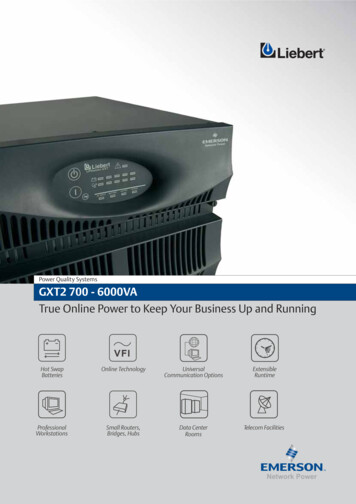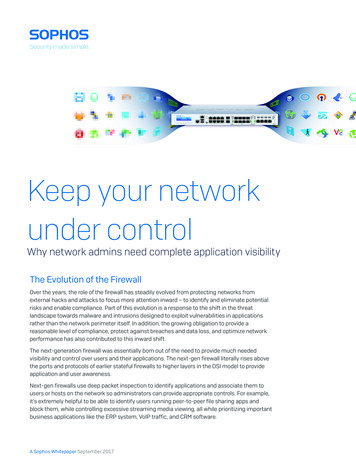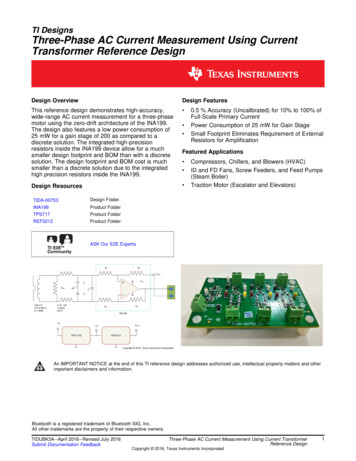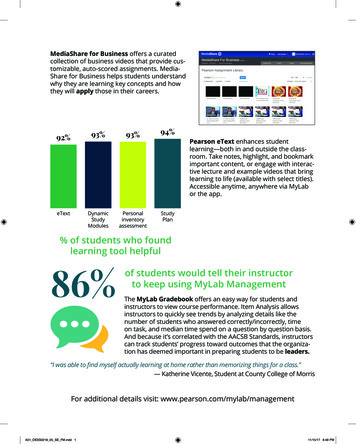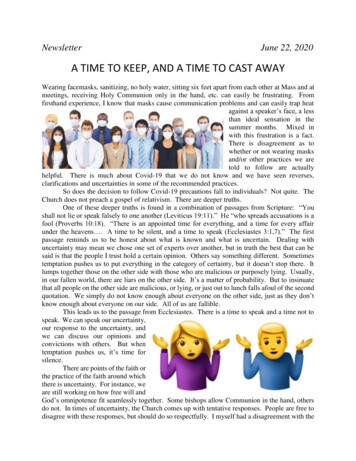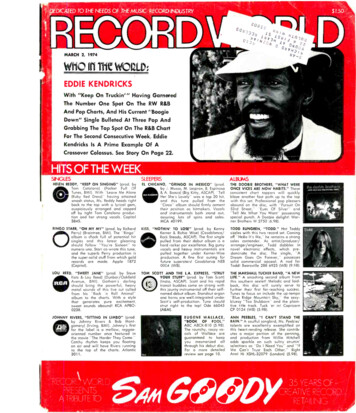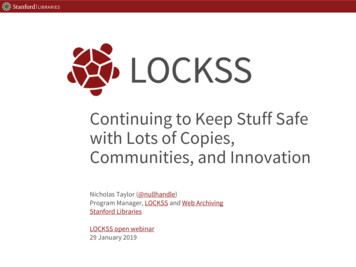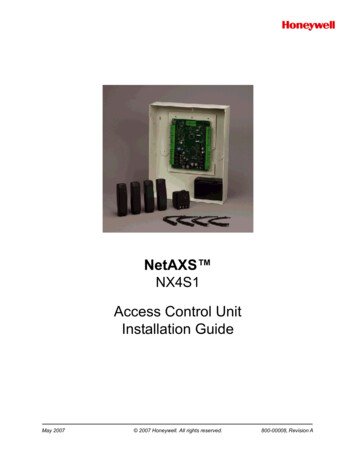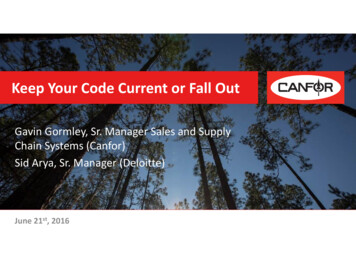
Transcription
Keep Your Code Current or Fall OutGavin Gormley, Sr. Manager Sales and SupplyChain Systems (Canfor)Sid Arya, Sr. Manager (Deloitte)June 21st, 2016
Objectives Considerations around application of ESUs versus upgrade to the nextversion of the application Mitigate risks for future application and ESU upgrades Learn about key success factors for the projectC A N F O RC O R P O R A T I O NPage 2
IntroductionSid AryaSenior ManagerSid has over 18 years of consultingexperience that includes ERPassessments, business process redesign,net new implementations, upgrades ofERP Applications, transition planning andproject management.He has over 17 years’ experience implementingvarious releases of Oracle JD EdwardsEnterpriseOne software for companies of allsizes in countries such as India, Singapore,Malaysia, Thailand, Philippines, Australia, NewZealand, USA and Canada.Project EDGE Role:Project Management Team MemberC A N F O RC O R P O R A T I O NGavin GormleySr. Mgr, Sales & SupplyChain SystemsGavin leads Canfor’s Sales & SupplyChain Systems team within Corporate ITand has extensive ERP implementationexperience.He has over 20 years of experience inapplications development and supportmanagement with a wide range of ERPsystems including JDE, PeopleSoft, andMicrosoft Dynamics products.Project EDGE Role:Project Management Team MemberPage 3
About Canfor
Company Profile: Canfor– Lumber capacity: 6 billion board feet perannum– 12 mills in British Columbia– 1 in Alberta– 17 operations in U.S. SouthLumber Mills– 3 - South Carolina– 1 - North Carolina– 3 - Georgia– 3 - Alabama– 1 - Mississippi– 1 – ArkansasOther– 2 - Laminating Plants Arkansas & Georgia– 1 Re-Manufacturing Mill South Carolina– 2 Chip Mills - Texas & Louisiana– 6500 employeesC A N F O RC O R P O R A T I O NPage 5
One of the Largest Integrated Forest Companies Pulp and Paper Operations–3 Kraft Pulp & 1 Paper mill in central BC 1 BCTMP mill in BC north Market pulp capacity: 1.1 million tonnes Kraft paper capacity: 140,000 tonnesC A N F O RC O R P O R A T I O NPage 6
A World Leader in Sustainable ForestryCanfor is one of the few primarylumber manufacturers to offerproducts third-party certified to all ofthe independent certificationprograms in North AmericaPercentage ofProductionCSAFSCSFITotalCanadian mills85%10%5%100%--100%100%US millsC A N F O RC O R P O R A T I O NOur success depends on the well-beingof the forests we manage. Through allof our forest management activities, ourskilled forest professionals protect:-BiodiversitySpecies at riskWildlifeOther Forest ValuesPage 7
The Journey.
JDE Implementation Phase 1 - Background Canfor made a strategic decision in 2012 to replace its bespoke legacy applications andprovide a platform that would support expansion, standardization, and unification across itsoperations Canfor implemented version 9.1 of the JD Edwards (JDE) system in July of 2014 to supportits Canadian lumber operations Key system components support: demand forecasting, production planning, supply chainmanagement, sales, purchasing, inventory management, transportation planning andexecution, finance functions, and business analytics The implementation has been tailored to Canfor’s unique and specific needs and closelyintegrated with other peripheral products such as Oracle Transportation Management (OTM),Demantra, Oracle E-Business Suite (EBS), and a number of in-house developed applicationsC A N F O RC O R P O R A T I O NPage 9
Project Timeline – Phase 152025MONTHSC A N F O RC O R P O R A T I O N10Page 10
Application Footprint – Phase 1Identifying opportunities toaccelerate configuration anddocumentation activities wasparticularly beneficial due to thescope of work: Deloitte LLP and affiliated entities.C A N F O RC O R P O R A T I O NConfiguring 10 JDE ModulesDeveloping 95 JDE WFRICEobjectsDocumenting systemconfiguration in Design BooksDeveloping knowledge transferand training documentation11Page 11
JDE Implementation Phase 2 - Background Canfor has since acquired a number of other businesses in the US South. The project team continues to explore synergies in design by looking forward to the potentialacquisitions and integrations in the future. The system was subsequently launched at Canfor’s locations in the south eastern US inSeptember of last yearC A N F O RC O R P O R A T I O NPage 12
Project Timeline – Phase 34567891011MONTHS Deloitte LLP and affiliated entities.C A N F O RC O R P O R A T I O N13Page 13
EDGE ApplicationsPPTProduction PlanningToolDRPDemand PlanningJDEJD Edwards ERPInventorySales OrderQUOTEAFSQuotes ApplicationAvailable For SaleWork OrderMaterial PlanningFoundationFULFILLMENTQuotes ApplicationAvailable For SaleGLAPARPODGSData Gathering SystemDEMDemantra ForecastingC A N F O REBSEnterprise LSUSSTransportationMP2USS MROKronosUSS PayrollOBIEEBusiness IntelligenceReporting.Net ApplicationC O R P O R A T I O NProcurementUSSProcurementOracle ApplicationUSS ApplicationCanada Application14Page 14
Canfor’s Legacy ApplicationsS#ApplicationPurposeImportance to CanforFinal Disposition1KronosPayroll & GarnishmentssystemPayroll, HR, and HumanResource ManagementRetained – Integrated with JDE2Infor MP2 – MaterialPlanningMRO systemMills and Plant manage all WorkOrder and Purchase Orders withthis systemRetained – Integrated with JDE3Log ProcurementLog Purchasing and TractManagement systemCustom application specific toUSS operations Log operationsRetained – Integrated with JDE4iNSELS – Integrated NewSouth Express LogisticsSystemTrucking FleetManagement & BackhaulInvoicesManages dispatch operationsfor Fleet and Drivers (Canforemployees) including BackhaulbusinessRetained – Integrated withOTM/JDE5FAS – Fixed Asset SystemDepreciation and FixedAsset ManagementSystem6DGS – Data GatheringSystemLumber Production datacollectionLeverage existing productiondata collection investmentRetained – Integrated with JDE7Koppers Wood TreatingSystemTreated LumberProcessing datacollectionProvide connection of treatingprocess to availability ofinventory statusRetained – Integrated with JDEthrough DGS87iMRO SystemImplementation deferred toPhase 39ADPPayroll systemImplementation deferred toPhase 3C A N F O RC O R P O R A T I O NRetained – No integration toJDE – uses Manual JE’s15Page 15
JDE Implementation Phase 3 - Background The system is currently being extended for use in the locations in Alabama, Mississippi,Georgia, and Arkansas and is expected to be live early in 2017 The focus has shifted from technology to business integration, change management andadoption as a result of the work done by the project team upfront. Future expansion plans are also in the pipeline to expand the footprint furtherC A N F O RC O R P O R A T I O NPage 16
Timeline – Feb 2017 Go ESIGN / BUILDDesign D. &FSDsAnthony TripDevelopment& FUTConfig. &Design BooksIntegrationTestingCRP 2UAT (UserAcc. ePost Go-LiveSupportC A N F O RC O R P O R A T I O NNote – Operate Phase is likely to be 13 weeks; includes 7 weeks Deloitte Onsite support and additional 6 weeks support by a Canfor led Support team.Page 17
The real thing.
Motives for keeping JDE current To obtain the most recent product improvements and features To obtain any security patches and corrections To ensure supportability and extend product life expectancy – i.e. avoid obsolescence andmaximize the initial software capital investment returns To aid in compatibility with external dependent software products To retain valued IT staff members by ensuring their skillsets are maintained currentC A N F O RC O R P O R A T I O NPage 19
Costs and Considerations in Applying Updates Customized add-ons need to be retrofitted to ensure compatibility Functionality needs to be regression tested – especially where interfaces to external systemsare concerned Stakeholders (end users) need to invest time and effort to perform testing which can beperceived as detracting from their main responsibilities Multiple environments need to be provisioned and maintained Concurrent development and configuration needs to be carefully managed during theupdating process System and end user documentation may need to be updated End users may need retraining Communications, coordination, release management and rollback plans must be carefullymanagedC A N F O RC O R P O R A T I O NPage 20
JDE 9.2JDE 9.2 became generally available on Oct 6, 2015Upgrade ProcessSupport for 9.2Simplified Upgrade available for customers moving from 9.0 Update 2 and abovePremier Support until Oct 2020, Extended Support until Oct 2023Support for 9.0.2 to9.1Premier Support expiring between Nov 2015 & Mar 2017Extended Support expiring between Nov 2018 & Mar 2020Count of new feature functionality for End User: 30, Developer: 02, CNC: 03Expanded User Id & password, Simplified UI Navigation (Kiosk mode), Recent Breadcrumbs, Email & CalendarIntegration, CafeOne, Watchlists, User Defined Objects, Media Objects drag & drop, Real time summarizationInternet of Things (IoT) OrchestratorOne View Reporting improvements, One View Financial StatementsNew FeaturesOptimized user interface, advanced end user query capabilities, improved IT administration functionality and highavailability and disaster recovery enhancements, BI Publisher: Improve the formatting and delivery of output withpixel-perfect output.Web Services: Interface with other technologies in a standardized toolset.Performance Enhancements – code optimization and database enhancementsNew ModulesReleasedNew Mobile Applications, Advanced Job Forecasting, Outbound Inventory Management, Rental Management9.2 InitiativesUpgrade Workshops run by several Oracle business partners across North AmericaFastest Upgrade Contests by OracleMore InformationSocial MediaC A N F O RLearnJDE.com, UpgradeJDE.com, Oracle.com, Support.Oracle.com#AskJDEdwards, #JDEIdeasC O R P O R A T I O NPage 21
Electronic Software Update (ESU) vs. Upgrade to 9.2ESU /UpgradeESUCurrent State JDE 9.2wasreleased onOct 6, 2015 EffortSignificantlybehind onESUsLast discussionaround applyingESUs was inOct 2014Since then 21new baselineESUs havebeen releasedFinance moduleis now beingfully used byCanfor930 hrs.retrofitand UTfor 25identifiedobjectsCanfor isrunning Apps9.1 (Tools9.1.4)No businessdriver for anupgrade exceptthe need to becurrent with thelatest ESU’s1500 hrs.retrofit &UT for 39identifiedobjectsRequired By CFPCSP-EastCSP-WestRegression TestingEffort CFPCSP-East Approximately 200person hrs. effortfor CFPApproximately 100person hrs. effortfor CSP Re-TrainingNo requirement forRe-training Become currentwith ESUs anddelay upgradingto 9.2 to a laterpoint – see slide3 for scheduleoptionsPremier supportwill end by Mar2017Impact of Decision People - Less resource intensiveand focused on the objects that theESU touches mainly the Financemodule Process – No change to anyexisting processes Technology - Be current with allcode optimizations and ESUs thathave been released by OracleTechnology - Canfor will not haveoptions to use some of the newerfunctionality available with 9.2 suchas iOT Orchestrator. Real TimeSummarizations, InteractiveFinance Integrities etc. As above As above C A N F O RFuture StateC O R P O R A T I O NRe-training onnew user interfacewill be required forCanada, CSPEast.Based on previousupgrades theretraining programmay require 2weeks of instructorled trainingNew UPKs will berequired fornavigation andinterface changesDepending on theschedule ofimplementationchosen may berequired by CSPWest Be on the latestJD Edwardsrelease (Apps9.2, Tools 9.2)in 2016 and beable to utilizethe new feature/ functionalityduring the CSPWestimplementationPremier supportextended to Mar2020 People - Will require extensiveinvolvement from businessresources to adequately test thesystem, project management toplan, cutover, go live and post golive support Process – potential changes inprocess based on evaluation of netnew functionality and existing painpoints Technology - Be current with allcode optimizations and ESUs thathave been released by OracleTechnology - Gives Canfor theability to utilize new feature /functionality that is available in 9.2Technology - Bleeding edge oftechnology - unable to predictenvironment stability Page 22
Canfor’s Decision: Version Upgrade vs. Apply ESU Canfor’s decision was based on a formal analysis weighing the costs, benefits, and risks oftwo primary options Implicit tertiary option was quickly discounted – i.e. do nothing now and postpone until later Upgrading and maintenance are not mandatory, however, based on the motives statedpreviously, they are usually preferable Maintenance is effectively inevitable – especially for a critical business system, the decisionis not “if” it is simply “when” How many of you have faced (or are facing) the decisions of Upgrade vs. Patch and whattiming makes sense?C A N F O RC O R P O R A T I O NPage 23
Key Success Factors Business continuity and system reliability Maintenance of balance between adequate testing and minimized end user disruption Code base control during parallel development Dedicated team members to focus on the ESU retrofit Achievement of the previously stated objectives:– Improved system security– Future compatibility/supportability– Maintenance of IT staff skill currency Prepar
PPT Production Planning Tool DRP Demand Planning QUOTE AFS Quotes Application Available For Sale DGS Data Gathering System DEM Demantra Forecasting.Net Application Oracle Application JDE JD Edwards ERP Inventory Sales Order Work Order Material Planning Foundation GL AP AR PO OTM Oracle Transportation Management FULFILLMENT Quotes Application Available For Sale
